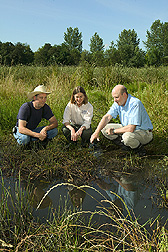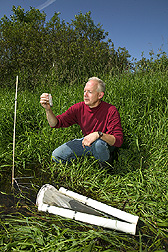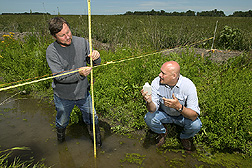Grass Farming and the Environment
Fish and Wildlife Thrive on Farms in Western Oregon
The Willamette Valley in Oregon, starting near Portland and running south of Eugene, is known for its fine wines. Another important regional farm product is grass seed, produced on hundreds of thousands of acres that supply much of the United States and world with seed for lawns, golf courses, parks, and pasture.
For part of the year, this section of Oregon can be relatively dry. But from October through May, the area averages 37 inches of rain—a little more than three-fourths its 48-inch annual rainfall. Much of the rain flows over the grass seed fields and into seasonal channels. It’s in these channels that many types of fish and other aquatic creatures dwell for part of the year. Trees and brush alongside the fields and channels are also home to birds and other wildlife.
A diverse group of scientists, led by the ARS Forage Seed and Cereal Research Unit in Corvallis, is determining which species use the seasonal drainages and how farmers can best manage their fields while preserving natural resources.
“We’ve found that grass seed farms can provide good habitat for wildlife while producing income for the grower,” says Jeffrey J. Steiner, an agronomist in the Corvallis laboratory.
Judith Li, Oregon State University (OSU) stream ecologist, and Guillermo Giannico, State Fisheries Extension Specialist, surveyed the kinds of fish found in the drainages and determined that 98 percent are native to the Willamette Valley. Kathryn Boyer, a fisheries biologist with ARS’s fellow agency, the Natural Resources Conservation Service, says she was surprised by the number of different species found, such as the western pond turtle, Chinook salmon, redside shiner, and red-legged frog. “I didn’t think there was going to be such a diversity of aquatic life in these drainages,” she says.
Working with Li and Giannico, Steiner and OSU entomologist Bill Gavin have also been learning what the fish eat. “When we began our research, we thought small invertebrates that help decompose straw in the seed fields would be washed into the drainages and eaten by the fish,” says Steiner. “As it turns out, the fish are mostly feeding on aquatic invertebrates found in the slow-moving drainages near fields,” he said.
The scientists think that one reason there are so many native fish in these streams is that the land use in the area has changed little over time. Much of this part of the Willamette Valley was wet prairie grassland until settlers introduced agriculture. Today’s grass seed fields are somewhat similar to those original prairies, so they may provide some of the natural landscape features from the past that are mostly lost today.
In the nearby trees alongside the streams and seed fields, songbirds make winter homes. Doug Bilsland, OSU faculty research assistant, is helping University of Massachusetts wildlife ecologist Brenda McComb study these birds.
They have found 60 of the roughly 200 Oregon species of birds. Bilsland first thought the abundance of water was what attracted the birds. “Over time, we found that water is not as important as the amount of tree and brush cover near the streams and fields,” he says.
ARS agronomist George Mueller-Warrant is using computer Geographic Information System tools and satellite images to compare areas where fish and birds are thriving to areas where conservation practices are used, and hydrologist Gerald Whittaker is developing computer programs to show the most economical combinations of conservation practices.
An Eye on the Environment
Often there is concern that farming harms waterways. But many of the grass seed farmer’s practices are designed to preserve water quality. Careful attention to timing and placement of agricultural chemicals, based on ARS and OSU research findings, greatly reduces the amount that might end up in streams.
Plant physiologist Stephen M. Griffith, who works at the Corvallis lab, says that no-till planting can also help protect water quality. “Plowing before another crop is planted disturbs the soil, so nutrients and sediment could end up in the water,” says Griffith.
No-till planting reduces those losses and can also be better for the farmer’s bottom line. Average no-till planting costs $78 less per acre than planting by conventional tillage. And seed yields are often higher with no-till practices.
Griffith, Whittaker, and Stephen Schoenholtz, OSU forest engineer, are studying larger scale aspects in this project to determine the relative differences of agricultural and forest land uses on water quality at the watershed level. Results from the research will be used in efforts such as USDA’s Conservation Effects Assessment Program.
The researchers credit local producers for being conservation minded and allowing this research to be done on their farms. Steiner says more than 25 farmers have given access to their farms to determine amounts of nutrients and sediment in their drainages and to pinpoint when and where fish are found.
“There’s a lot of participation because farmers want to know how they are doing,” he says. “These farmers care deeply for their land. Some families have been farming here for more than 140 years.”
Mark Mellbye, OSU extension agronomist, works with farmers to identify practical conservation practices. Establishing wildlife buffer plantings and maintaining vegetation along drainages and field borders, instead of spraying weeds, is one such practice. The benefits are being demonstrated with the on-farm trials and promoted at grower workshops.
Giannico believes that the farmers’ practices show that they can make a profit while helping wildlife to thrive. He sees an interest for improvement to ensure that the streams continue to be good fish habitats.—By David Elstein, formerly with ARS.
This research is part of Integrated Agricultural Systems, an ARS National Program (#207) described on the World Wide Web at www.nps.ars.usda.gov.
Jeffrey J. Steiner, Stephen M. Griffith, Gerald W. Whittaker, and George W. Mueller-Warrant are in the USDA-ARS Forage Seed and Cereal Research Unit, 3450 S.W. Campus Way, Corvallis, OR 97331; phone (541) 738-4121, fax (541) 738-4160.
"Grass Farming and the Environment" was published in the October 2005 issue of Agricultural Research magazine.










